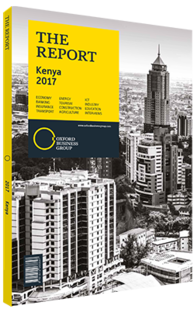Fixed income segment
Annual bond turnover surged by 42% in 2016 to reach KSh434.7bn ($4.2bn), up from KSh306.2bn ($3bn) in 2015. The highest trading level was recorded in the second quarter, at KSh144.2bn ($1.4bn), on the heels of significant government security redemptions and government borrowing over the period. The heightened activity coincided with the “normalising” of the yield curve, which had inverted in the first quarter and led to a bias towards short-term Treasury bills (T-bills). This ramped up 2016 activity was attributed to dimming return prospects in the equity segment, with annual 2016 turnover dipping to KSh147.18bn ($1.4bn). The interest rate capping legislation has led to an increased bias towards government securities trading by banks, which are the biggest players.
Bear Run On Equity
The fiscal deficit for FY 2017/18 represents a decline to KSh523.65bn ($5.11bn) – 6.30% of GDP – from KSh665.40bn ($6.49bn), or 8.90% of GDP; slightly higher than the National Assembly recommended KSh500.00bn ($4.88bn) – 6.00% of GDP – target hole. Risks on the financing front will emerge as proposed KSh328.89bn ($3.21bn) of domestic borrowing has exceeded the 60:40 external borrowing to domestic ratio as approved by the Medium Term Debt Management Strategy. The over-reliance on domestic borrowing will further crowd out the private sector as banks have cemented their position as the largest lenders to government in the post-interest cap era.
Data as at first half of the current FY 2016/17 showed that the government had a net borrowing of KSh156.63bn ($1.53bn). This represents a performance rate of 38.52% of the total KSh406.61bn ($3.97bn). The central bank cancelled the KSh30bn ($292.7m) January bond issue, perhaps on low uptake or aggressive investor bidding. The low acceptance rate in the February infrastructure bond issue augmented the regulator’s intent on curbing aggressive bidding. The first quarter of 2017 sequel ends with a TAP Sale on a plain vanilla March issuance, in the wake of 38.70% acceptance of the KSh64.25bn ($626.9m) bids received. The clear message is that the regulator has implicitly capped yields – against investors’ preference – with the intended effect of backtracking domestic borrowing. Our 2017 expectations are geared for a slight uptick in the short end of the yield curve on account of shilling pressure.
T-Bills
Yields on T-bills came down from their elevated levels at the start of 2016 on the back of subdued government borrowing in the third quarter of 2015 and debt redemptions in the first quarter of 2016. The yields started inching upwards on account of anticipated inflationary pressures towards the end of the year. The discount securities returned a sub-par performance – particularly at the tail end of the year, which points to stability in the yields at current levels. We expect upward swings in the second quarter with the anticipated inflationary environment.
Shilling Pressures
The US dollar-Kenya shilling pair remained fairly stable throughout 2016, but the local currency came under pressure from the strengthening US dollar in the final part of the year. The dollar’s strength resulted from the anticipated re-ignition of the US economy caused by escalated fiscal easing and an expected increase in the number of US rate hikes by the US Federal Reserve in 2017. A worsening current account deficit is projected to result in a ballooning import bill. Foreign reserves held at the central bank averaged $7.49bn in 2016, equal to 4.88 months of import cover. A low import bill, diaspora remittances and tourism uptick helped boost the reserves in the second and third quarters of 2016. However, the gradual depletion of the reserves – in defence of the local unit – took the foreign reserve level below the 2016 average, at $6.97bn, or 4.56 months of import cover.
The $1.5bn precautionary facility from the International Monetary Fund, once available, will help cushion the local currency against the detrimental effects of the strengthening dollar. We anticipate the shilling’s performance to remain range bound in 2017.
You have reached the limit of premium articles you can view for free.
Choose from the options below to purchase print or digital editions of our Reports. You can also purchase a website subscription giving you unlimited access to all of our Reports online for 12 months.
If you have already purchased this Report or have a website subscription, please login to continue.

